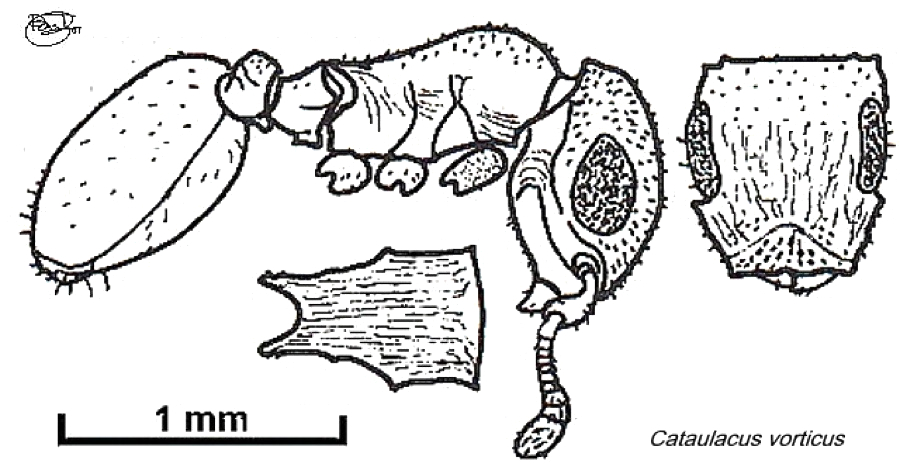Cataulacus vorticus Bolton
  Type location Nigeria
(Bolton, 1974a: 38, illustrated, full-face view and dorsal alitrunk,
all forms) Type location Nigeria
(Bolton, 1974a: 38, illustrated, full-face view and dorsal alitrunk,
all forms)  . .
Bolton's description is at  . .
|
 Nigeria
specimen (Taylor, 1979: 15). WORKER. TL 3.4-3.5 mm, HL 0.84-0.90, HW
0.74-0.82, SL 0.40-0.44, PW 0.52-0.56 Nigeria
specimen (Taylor, 1979: 15). WORKER. TL 3.4-3.5 mm, HL 0.84-0.90, HW
0.74-0.82, SL 0.40-0.44, PW 0.52-0.56
Occipital corners with a small triangular tooth and an adjacent
denticle. Sides of head behind the eyes shallowly convex, with minute
denticles. Dorsum of head and alitrunk rugoreticulate, with a
longitudinal trend posteriorly. Hairs on clypeus and dorsum of head are
strongly clavate. Remaining dorsal surfaces have numerous short, fine
simple hairs. Pronotum hardly marginate but the humeral angles are
acute and prominent, with a single tooth laterally close to the
junction with the mesonotum. Propodeal spines moderately long but
blunt. In profile the anterior and posterior faces of the petiole meet
dorsally at a near right-angle. The post petiole has a convex dorsum.
Subpetiolar process is simple with a sharp posteroventral angle.
Subpostpetiolar process simple, short and digitiform.
The holotype and paratype workers, with males and
females were collected by Bolton (30.viii.1969) from a nest under the
bark of a moss-covered cocoa tree at the Cocoa Research Institute of
Nigeria, Idi Ayunre. My specimens were on the trunk of a shade tree.
Bolton
(1974a, Introduction) noted that it, as Cataulacus species H,
probably was collected by Room (1971) from cocoa canopy and mistletoe
at the Mamfe-Mampong cocoa farm in Ghana.
Also known from Zaïre (Bolton, 1974a), and Cameroun
(Bolton, 1982: 356, in key), perhaps at Nko'emvon (D.A.
Jackson).
|